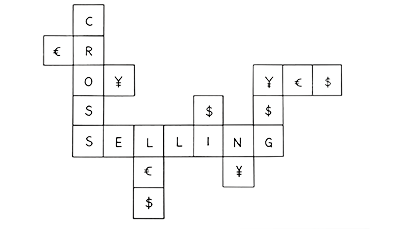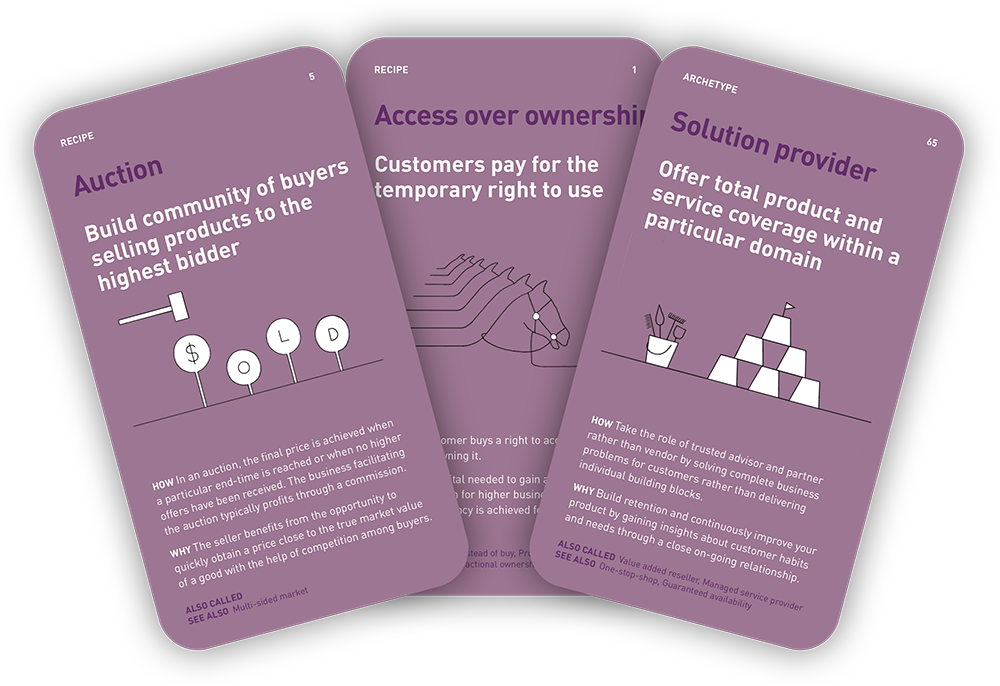Recipe
Also called: Bundling
| Key Partners | Key Activities | Value Propositions | Customer Relationships | Customer Segments | |||||
| Key Resources | Channels | ||||||||
| Cost Structures | Revenue Streams | ||||||||
How: Map complementary products across industries to build convenient unique combinations of products to customers.
Why: Exploit existing customer relationships to sell more goods with relatively few changes to the existing infrastructure.
This business model is part of the Business Model Patterns printed card deck.
A collection of business models that will help you understand the key drivers of business model success. The card deck will be ready for purchase in the end of 2023 and is now undergoing rigorous testing.
Reserve your deck!Exploiting Existing Customer Relationships. Cross-selling involves expanding upon a company’s core offerings by presenting complementary products and services to its existing customer base. This strategy allows a business to capitalize on pre-existing customer relationships and utilize its existing resources and expertise in sales and marketing.
For consumers, the primary advantage of cross-selling lies in the convenience and cost-saving potential of obtaining multiple products and services from a single, trusted source. In addition to practical benefits, cross-selling also fosters a sense of security and reliability among customers who have already established a positive relationship with a business.
Maintaining customer satisfaction is crucial when implementing a cross-selling approach. Careful planning and management of a company’s product portfolio is necessary to prevent any potential frustration that may lead customers to turn away from their original product.
Where did the Cross Selling business model pattern originate from?
The practice of cross-selling can be traced back to the bustling bazaars of ancient Middle Eastern merchants. Today, this strategy is utilized by companies across a variety of industries, with Royal Dutch Shell serving as a prime example.
Shell, the oil and gas giant, has implemented an innovative business model centered on cross-selling. The company leverages its extensive network of petrol stations to sell a diverse array of goods unrelated to the oil industry, such as groceries and other everyday items.
The origins of this strategy at Shell are the stuff of legend: the story goes that a KFC franchisee located within a Shell petrol station sparked the idea of cross-selling by allowing customers to refuel both their cars and themselves. The combination of food and petrol proved so successful that Shell swiftly applied the concept of cross-selling to other areas of the business.
Applying the Cross Selling business model
Combining Low and High-Margin Products. Cross-selling holds significant potential in situations where a basic, low-margin product or service can be paired with higher-margin products. This is often the case in the consumer goods industry, where customer convenience can drive additional purchases, such as food at petrol stations.
The cross-selling pattern also has practical applications in the B2B sector, where specialized products can be bundled with other products or services. For instance, a company might offer a package deal that includes high-rise elevators in a building, along with low-rise commodity elevators and escalators. Similarly, a business could bundle new escalator installations with maintenance services. These types of bundled offerings typically appeal to customers seeking a one-stop shop solution.
In the B2B realm, cross-selling is often used in conjunction with the Solution Provider pattern.
Trigger Questions
- How can you use customer data to discover and build out cross-selling opportunities?
- How can you persuade customers that cross-sold products are beneficial and complementary, not replacements or upgrades?
- Is it possible to bundle the product in a way that is beneficial to customers?
- Is the customer's perceived value of cross-selling sufficient?
- Is there a natural inclination for customers to bundle the products?
- Are we able to maintain consistent pricing for these products?
- Are the barriers to market entry for potential competitors sufficiently high?
Examples
IKEA
With affordable furniture at its core, IKEA cross sells equipment, replaceables, in-store dining, and grocery shopping.
Amazon Store
On top of just showcasing related items, Amazon pioneered showing items other similar customers bought.
Tchibo
The German coffee retailer and chain, has successfully implemented a cross-selling-based business model. The company, which was originally founded as a mail-order coffee business, has progressively added non-coffee products to its range. In 1973, Tchibo established a separate division for non-food products and began offering a wide variety of items for a limited time under the slogan “A new experience every week.” These offerings, which include household goods, clothing, jewelry, and insurance, account for approximately 50% of Tchibo’s revenues and more than 80% of its profits. The company’s extensive product range has contributed to its strong brand recognition in Germany, with 99% of Germans familiar with Tchibo.
- Business Model Navigator by Karolin Frankenberger and Oliver Gassmann
- 22 Cross-Sell Examples for Your Ecommerce Store by Michael Ugino

